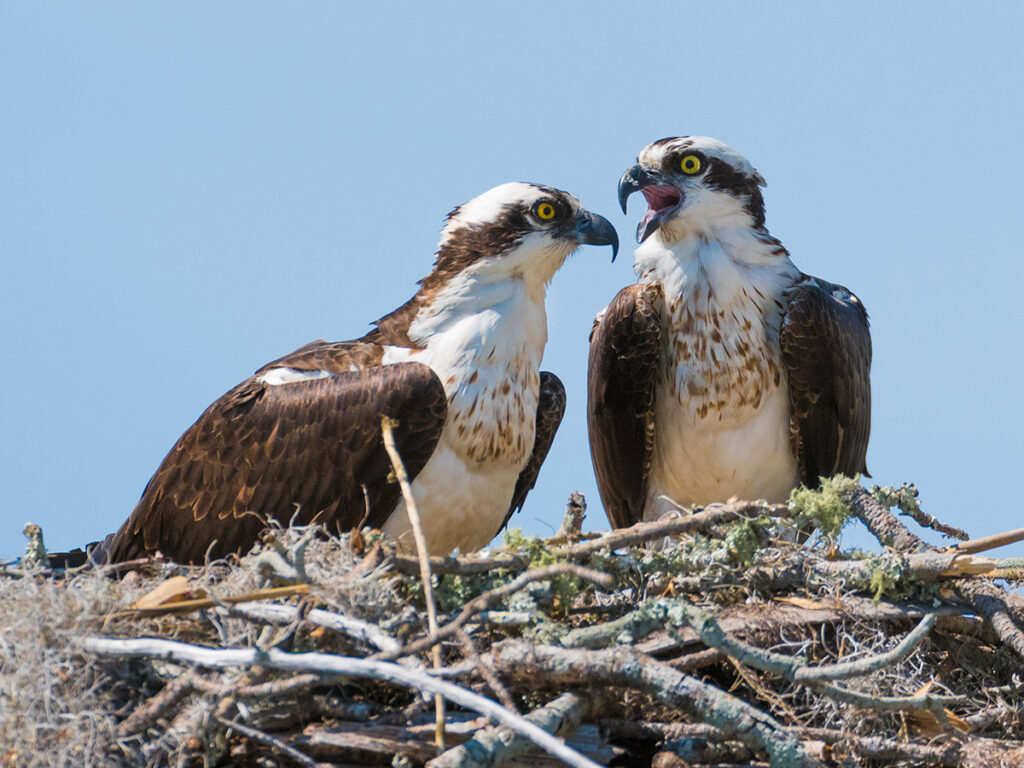The osprey, often referred to as the “fish hawk,” is one of the most impressive birds of prey, known for its incredible fishing skills, striking appearance, and migratory behavior. Found near bodies of water across the globe, ospreys have captured the

imagination of bird watchers and nature enthusiasts alike. This guide will help you learn more about these remarkable raptors, their natural habitat, diet, and conservation status.
What is an Osprey?
The osprey (Pandion haliaetus) is a large raptor, or bird of prey, found near rivers, lakes, and coastal regions worldwide. Recognizable by its white underparts, dark eyestripe, and characteristic long, hooked beak, the osprey is built for hunting. Its wingspan can reach up to 6 feet, and it has a distinctive white head with dark eyes and a stripe running down its face, which adds to its striking appearance.
Ospreys are known for their specialized hunting techniques—primarily, they are fish-eaters and have adapted perfectly for this diet. They are often seen hovering over water before diving feet-first into the water to catch their prey.
Osprey Habitat and Distribution

Ospreys are highly adaptable birds that can live in a variety of habitats, but they are typically found near bodies of water. This includes freshwater lakes, rivers, coastal wetlands, and even marshes. They can be found on every continent except Antarctica, with significant populations in North America, Europe, Africa, and parts of Asia.
During the breeding season, ospreys prefer tall trees or man-made platforms near water where they can build their large nests. In the winter months, ospreys migrate to warmer climates, traveling as far as South America, Africa, and Southeast Asia.
Diet and Hunting Techniques
As fish-eating raptors, ospreys are equipped with some of the best adaptations for hunting in the water. Their diet primarily consists of fish, but they have been known to occasionally hunt small birds or mammals when fish is scarce.
Here are some fascinating facts about the osprey’s hunting methods:
Ospreys have excellent eyesight that allows them to spot fish from great heights, often diving from as high as 100 feet (30 meters) to catch their prey.
The osprey’s feet are adapted for catching slippery fish. Their talons are covered with spines that grip onto the fish securely, allowing them to carry their catch in flight.
Ospreys dive feet-first into the water at incredible speeds. They have waterproof feathers and a specialized outer coating that helps them stay dry while fishing.
Breeding and Nesting
Ospreys are highly territorial during breeding season, and they build large nests that are often reused year after year. Their nests are usually located in tall trees, cliffs, or man-made structures like power poles or platforms. These nests are typically built out of sticks, seaweed, and other available materials, and they can be as large as 4 feet (1.2 meters) across.
Ospreys are monogamous during the breeding season, and pairs often return to the same nesting sites year after year. The female osprey lays between one and four eggs, which both parents take turns incubating. Once the eggs hatch, the parents work together to feed and protect the chicks until they are old enough to fledge and leave the nest.
Osprey Conservation Status
While ospreys were once heavily impacted by the use of pesticides like DDT in the mid-20th century, conservation efforts have helped their populations recover. Ospreys are now considered a species of “Least Concern” by the International Union for Conservation of Nature (IUCN). They are widespread and abundant in many regions, though some local populations still face threats due to habitat destruction, pollution, and climate change.
Conservation programs have focused on protecting osprey habitats, providing nesting platforms, and ensuring the availability of clean, healthy water sources for fishing. Many bird-watching organizations and wildlife groups have also played a crucial role in monitoring osprey populations and promoting awareness of their ecological importance.
Interesting Osprey Facts
Ospreys are known for their impressive migratory behavior. Some ospreys travel thousands of miles each year to find warmer climates. In North America, they typically migrate south to Central and South America for the winter, and then return to their northern breeding grounds in the spring.
Unlike some other raptors, ospreys do not rely on stealth while hunting. Their method involves hovering above the water before diving in to catch their prey, often with a loud splash.
Because ospreys depend on fish-filled waters to survive, they are often considered indicators of the health of aquatic ecosystems. A healthy osprey population is a sign of clean water and thriving fish populations.
Ospreys can live for up to 15 years in the wild, although many don’t reach this age due to predation or accidents during migration.
How to Spot an Osprey in the Wild
Spotting an osprey in the wild is an exciting experience for any bird lover. Here are some tips on how to increase your chances:
Ospreys are often found near lakes, rivers, marshes, and coastal areas where they can hunt for fish.
If you see a bird hovering above the water, it could very well be an osprey. They tend to stay in one spot while scanning the water below for fish.
Ospreys build large nests that are easy to spot in tall trees, power poles, or man-made platforms.
Ospreys make a high-pitched whistle or whistle-like call, often heard when they are flying overhead or near their nests.
Conclusion: The Osprey’s Role in Our Ecosystems
Ospreys are not only stunning birds of prey, but they also play a vital role in maintaining the health of aquatic ecosystems. By keeping fish populations in check, ospreys help maintain balance in local food chains and contribute to the overall biodiversity of their habitats.
Whether you’re an avid birdwatcher or someone interested in protecting wildlife, supporting osprey conservation efforts is essential. By understanding their needs and habitat, we can ensure these majestic birds continue to soar high above our waters for generations to come.



